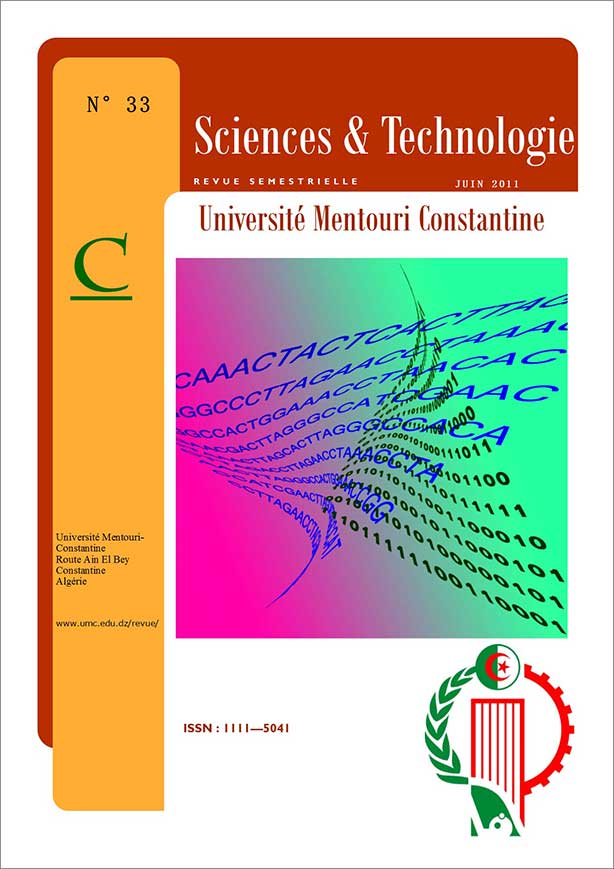CONTRIBUTION DES RESEAUX DE NEURONES ARTIFICIELS (RNA) A LA CARACTERISATION D’UN STRESS OXYDATIF CHEZ Saccharomyces cerevisiae INDUIT PAR LE CADMIUM. MISE EN EVIDENCE D’UN BIOMARQUEUR POTENTIEL (CAS DU MALONDIALDEHYDE)
Mots-clés :
Stress oxydatif, Biomarqueur, Malonaldéhyde, Cadmium, Saccharomyces cerevisiae, Réseaux neuronaux artificiels (RNA)Résumé
Le stress oxydant qui résulte, rappelons-le, d'un déséquilibre de la balance entre pro-oxydants et anti-oxydants, peut être évalué selon deux approches principales faisant appel à la mesure : - des systèmes anti-oxydants (enzymatiques et non enzymatiques), - des dommages créés par l'attaque des radicaux libres sur les principales cibles moléculaires biologiques (lipides, protéines, glucides etc…). La difficulté est de choisir tel ou tel biomarqueur pour apprécier son importance in vitro car on se heurte à des problèmes analytiques de spécificité et de sensibilité. L’analyse exploratoire de données expérimentales utilise fréquemment des outils statistiques. cet article présente l’applicabilité détaillée des réseaux neuronaux artificiels (RNA) et à leur contribution à l’étude de l’évaluation du stress oxydatif induit par le cadmium chez Saccharomyces cerevisiae. Il comporte une description de la méthodologie des RNA et l’avantage de l’intelligence artificielle sur l’analyse statistique actuelle.Références
- Calderon-Macias C, Sen M.K, Stoffa P.L, Artificial neural networks for parameter estimation in geophysics, Geophys. Prospect. 48 (2000).pp 21–47.
- Dowla F.U, Rogers L.L, Solving problems in environmental engineering and geosciences with neural networks, MIT Press, Cambridge, UK. (1995). pp 240.
- Das, N., Levine, R. L., Orr, W. C. and Sohal, R. S.
Selectivity of protein oxidative damage during aging in Drosophila melanogaster. Biochem. J. 360, (2001). pp 209-216.
- Almeida JA, Diniz YS, Marques SFG. The use of the oxidative stress responses as biomarkers in Nile tilapia (Oreochromis niloticus) exposed to in vivo cadmium contamination. Environment International 27. (2002). pp 673-679.
- Bonneris E, Perceval O, Masson S, Hare L, Campbell PGC. Sub-cellular partitioning of Cd, Cu and Zn in tissues of indigenous unionid bivalves living along a metal exposure gradient and links to metal-induced effects. Environ. Poll. 135. (2005). pp 195-208.
- Geret F, Serafim A, Barreira L, Bebianno MJ.. Effect of cadmium on antioxidant enzyme activities and lipid peroxidation in the gills of the clam Ruditapes decussatus. Biomarkers 7. (2002). 242-256.
- Lagadig, L, Cadet, T, Amiard, J.C, Ramade, F.. Biomarqueurs en ecotoxicologie : aspects fondamentaux. Masson.( 1997). 419 pages.
- Hagger, j, Jones, M, Lowe, D, Leonard, D.R.P., Owen,
R., Galloway, T. Application of biomarkers for improving risk assessments of chemicals under the Water Framework Directive: A case study, Marine Pollution Bulletin, vol. 56. (2008).pp. 1111-1118.
- Forbes, v., Palmqvist, A., Bach, L., 2006, The use and misuse of biomarkers in ecotoxicology, Environmental Toxicology & Chemistry, vol. 25.(2006). pp . 272-280.
- Barthet L. Contribution à l’évaluation de l’impact sur les écosystèmes de la valorisation de résidus de procédés thermiques en BTP. Thèse de Doctorat. Institut national des sciences appliquées de Lyon, France, (2003). 218 pages.
- Haubenstricker M.E, Meier P.G. , Mancy K.H. Rapid toxicity testing based on yeast respiratory activity. Bull. Environm. Contam. Toxicol. .vol 44.(1990). pp 669-674.
- McCulloch, W.S. Pitts, W. A logical Calculus of the Ideas Imminent in Nervous Activity. Bulletin of Mathematical Biophysics. vol 5.(1943). pp. 115-133.
- Fortin, V, Ouarda, T., Rasmussen, T.P, Bobée, B.
Revue bibliographique des méthodes de prévision des débits. Revue des Sciences de l’Eau. vol 4.(1997). pp. 461-487.
- Hecht-Nielsen, R. Neuro-computing, AddisonWesley, Reading, Massachusetts, USA. Solution for a distributed hydrological model and applications.(1990). pp. 89-93.
- Lippmann R.P. An Introduction to Computing with
Neural Nets. IEEE ASSP Magazine.vol 4. (1987). pp 4-22.
- Najjar Y, Ali H. On the Use of BPNN in Liquefaction Potential Assessment Tasks. Artificial Intelligence and Mathematical Methods in Pavement and Geomechanical Systems, Attoh-Okine (Editor). Vol. 75. (1998a). pp. 55-63.
- Najjar Y, Ali H. CPT-Based Liquefaction Potential
Assessment : A Neuronet Approach. ASCE Geotechnical Special Publication No.75, Dakoulas, P. et. Al. (Editors), (1) : (1998b). pp. 542-553.
- Najjar Y, Zhang, X. Characterizing the 3D tressStrain Behavior of sandy Soils: A Neuro-Mechanistic Approach. ASCE Geotechnical Special Publication. Filz, G. and Griffiths, D. (Editors) vol. 96. (2000). pp. 43-57.
- Riad S, Mania J, Bouchaou, L, Najjar, Y. Modélisation de la relation pluie-débit par les réseaux de neurones artificiels (RNA ou ANN) : Application a un bassin versant en zone semi-aride (Maroc). Colloque international sur l’Hydrologie des régions méditerranéennes et semi-arides. Montpellier,
France.(2003).
- Braddock, R.D., Kremmer, M.L. and Sanzogni, L Feed-forward artificial neural network model for forecasting rainfall run-off. Proceedings international congress on modelling and simulation (Modsim). The modelling and simulation society of Australia Inc., Hobart, Australia,pp. (1997).pp1653-1658.
- Campolo M, Andreussi P, Soldati A. River flood forecasting with a neural network model. Water Resources Research.vol 35.(1999). 1191–1197.
- Burden, F.R., R.G. Brereton, P.T. Walsh. Crossvalidatory selection of test and validation sets in multivariate calibration and neural networks as applied to spectroscopy. Analyst 122. Vol. 10. (1997). pp.1015-1022.
- Lallehem S , Mania, J. A. linear and non-linear rainfall-runoff model using neural network technique : Example in fractured porous media. Journal of Mathematical and Computer Modellling. N°1, Vol. 55, N° 615.(2002).
- Lachtermacher, G., Fuller, J.D. Backpropagation in hydrological time series forecasting. In : K. W. Hipel, A.I. MacLeod, U.S. Panu & V. P. Singh (eds), Stochastic and statistical methods in hydrology and environmental engineering, Vol. 3.(1994). pp. 229-242.
